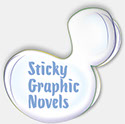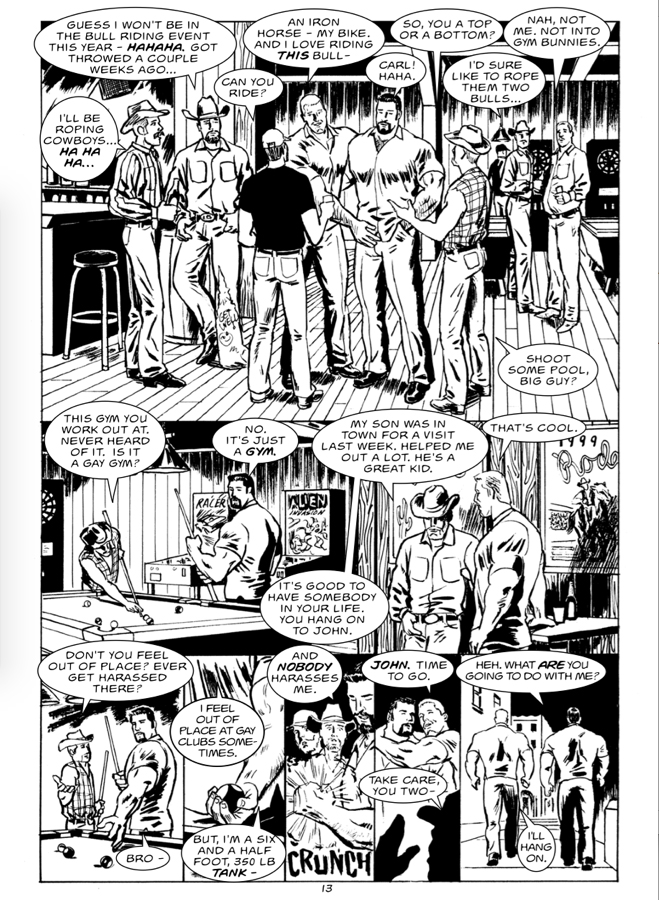- GUTTERFAGS -
Quarterly reviews of sequential art about
dude-on-dude lust and love
-- Back to the front page for more reviews!
Gutterfags is sponsored by Sticky Graphic Novels, an imprint of gay character-based, sex-positive graphic novels published in hardcover by Bruno Gmünder GmbH and in digital format by Class Comics.


Hearts and Iron
(Issues # 1 through 5)
by Jeff Jacklin
reviewed by Daniel Milco for Gutterfags
Hearts and Iron, by Jeff Jacklin, is a series of comic books presenting the story of Carl Hanson and John Sullivan, two immensely strong, muscular gay men in a loving relationship. What is striking about Hearts and Iron is that from the beginning, its world is neither all-accepting gay utopia, nor a tale of success (or ultimate failure) of isolated gay happiness against a backdrop of all-consuming homophobia, unrelenting misery, and/or other severe barriers.
The first three installments in the series, “Hearts & Iron”, “Clubland”, and “Judgment”, come together to tell a contemporary story in which John and Carl meet at a gym, and are instantly attracted to one another. However, they do not instantly come together, but spend the majority of the first volume skirting around each other and trying to determine whether the other is both gay and interested. Meanwhile, the secondary and supporting characters help flesh out the story and add multiple levels to the narrative.
These levels are enhanced by the diversity within the comic. Whilst at first glance the two hyper-muscular leads might imply a Tom of Finland-esque world in which all men look unrealistically, gorgeously alike, Jacklin avoids using body type as obvious shorthand, with positive, negative and neutral characters coming in all shapes and sizes. Carl’s rather dishy upstairs neighbour Al has a pronounced belly, as does a snarky one-shot character sneering at the presumed “steroid queens.” Thugs and homophobes are allowed to have toned and/or muscular bodies, and to be attractive on the outside, even as their repellent personalities are evident.
Despite the premise being that of two mutually-attracted hyper-muscular hunks (indeed, Carl frankly admits to preferring men similar to himself) a variety of relationships and pairings are shown. Al’s boyfriend, Angelo, is toned, rather than an exact echo of his partner, and Jacklin makes it obvious through their body language that Al and Angelo are deeply into each other. And why shouldn’t they be, after all? Not everyone is looking for someone like themselves. Even if this would appear to be the case from Jacklin’s lead characters, and his obvious love for muscular men, it can be seen from the background and supporting characters that they are just part of life’s rich variety. Indeed, in the first issue, John almost hooks up with a much shorter, slighter guy, Luis. However, they quickly discover that they are seeking different relationship models, and rather than this leading to angst, it is swiftly and courteously worked out between them. Such acceptance of what other people are looking for, or their choices, is a running theme of Hearts and Iron, where gay men can discuss their personal preferences and relationship models with each other, or with their straight friends, and not expect to be criticized for it. Responses such as “That’s not what we want” or “I know what I like” are readily accepted as answers even when the other person might be disappointed as a result. The only people explicitly passing judgment are the homophobes and a few background characters making assumptions about Carl and John based on their appearance. Indeed, homophobia is a very real – and realistic – menace in the books. In this sense, Carl and John are superheroes combating the dark forces, beating up queerbashers and combating other threats.
While there are familiar elements to his narrative, such as the homophobe repressing his own homosexual leanings, Jacklin avoids an over-reliance on clichéd storytelling. He uses forgivable tropes rather than tired devices. While some of the plot elements might be thought predictable, Jacklin offers his own spin on them. The aforementioned homophobe is given an opportunity to see the light and find redemption, something a lesser writer would make a tired cliché from. In Jacklin’s hands, the moment instead underlines the extent of the character’s dangerous delusions and the tragedy of his existence – while remaining completely true to the personality of the man we have gotten to know. At the same time, another character is given the opportunity to change his mind. He does indeed do so, but in a way that is legitimate to who he is, rather than a magical personality turnaround to be found in a sweet little gay fairy-tale – which, despite its romantic aspects, Hearts and Iron most certainly isn’t.
The following two-part story, “Entwined Lives”, takes a more fantastical turn, with the happy couple and their dog going camping. Whilst communing with nature, the clock turns back to Ancient Greece, telling the story of two very familiar looking muscular athletes, Kallikrates and Ioannes as they meet while practicing for the Olympics. The story of Kallikrates and Ioannes, involving the Greek Gods and many familiar elements of classical mythology, stands by itself, and as an echo-laden companion to the previous three installments. Like Orpheus did for Eurydice, one of the athletes descends into the depths of the Underworld to retrieve the other – and there is a pretty credible suggestion that one of Jacklin’s heroes is directly descended from Hercules, the strongest man in the world.
Presented in graphic black and white, Jacklin’s immediate and most obvious source of artistic inspiration is his childhood reading of the superhero comics of Marvel and DC. Looks wise, his muscular, immensely strong heroes could easily be characters from such publications, although their wonderfully explicit sexuality and prominent packages would undoubtedly have required toning down! Similarly, page layouts, fight scenes, and action poses show the influence of the superhero comic. As a keen weightlifter and martial arts practitioner since the age of 21, Jacklin is perfectly positioned to write and draw on his chosen subjects with authority. He literally understands muscles from the inside out, rather than piling tumescent mounds and rippling bulges onto lay figures in naïve hope that instantaneous sex appeal will result. I’m no sthenolagniac, but I genuinely appreciated and enjoyed the muscles displayed in these pages. For me, the real appeal lay in Jacklin’s full grasp of his characters’ personalities, showing clearly how they think and exist beyond their (admittedly impressive) physical attributes. Indeed, John intelligently and reasonably explains to an admirer how he achieved his body, and why it isn’t a good idea for the admirer to start taking steroids. This factomercial is delivered without preaching or hammering it over the reader’s head, but with the quiet authority of a writer who genuinely knows of what he speaks.
While the artwork may be black-and-white, the characters are definitely not. They are real people, capable of compromise, with the ability to alter their thinking, and even when stubborn and bull-headed, this is credible to their personalities. In addition to physical and emotional intelligence, Jacklin also eruditely brings knowledge to his work, never more immediately apparent than when bringing the culture and beliefs of Ancient Greece to life in “Entwined Lives”.
Without hesitation I recommend these graphic works to anyone looking for contemporary sex-positive gay material in this field. Hearts and Iron offers the visual joy of hot, sexy muscular men combined with the intellectual joy of intelligent writing. Having checked out Jacklin’s website, I look forward to future material from him.
- About the reviewer -
Daniel Milco lives and works in London. Under his full name Daniel Milford-Cottam, he studied English Literature and History of Art at BA level from Reading University, and holds a Master’s in Dress and Textile History from The University of Southampton. He has worked for 9.5 years (and counting) in a national museum, both as an assistant curator of fashion, and then as a cataloguer of immense numbers of prints, drawings and paintings, including historically non-publicized collections of erotica. He authored the book Edwardian Fashion (Shire Publications) and has contributed significantly to a number of publications on the history of fashion.